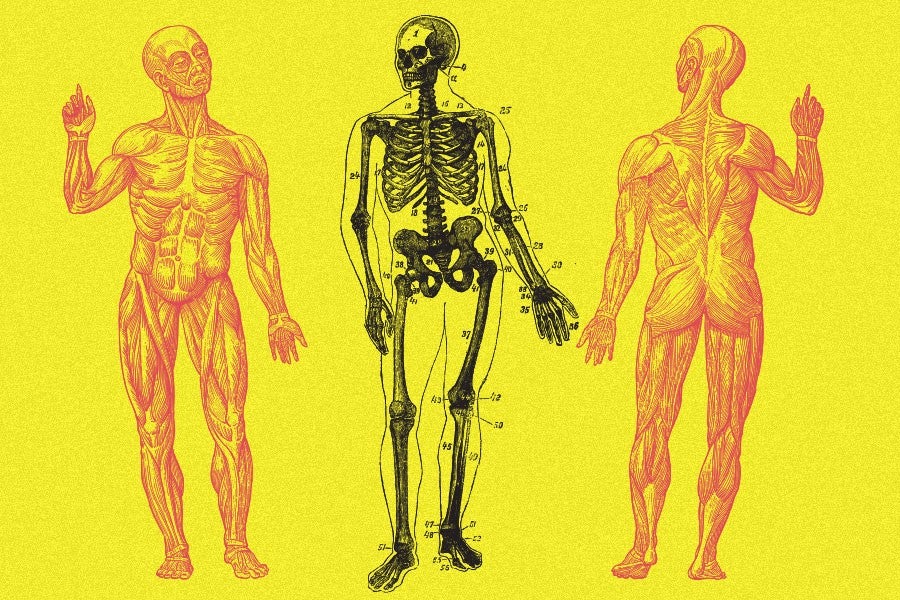If you’ve ever spent more than 20 minutes inside a gym, you’ll have noticed the wide variety of body shapes huffing and sweating alongside you. You’ll have seen hulking bench-pressers with pectorals like car doors, for example, alongside spectrally thin treadmill-pounders or office workers rowing against the rising tide of middle-age spread.
But what you’d have been unlikely to encounter is a human specimen in its pristine “natural state” — that is, a body truly representative of our species before the great, epoch-making advances such as agriculture, technology, sedentary lifestyles and triple chocolate cheesecake took hold of us and bent us all out of shape.
For a society obsessed with its various images of bodily perfection, it’s weird that very few of us have any idea of what this archetypal human form would actually look like. More to the point, is it even possible to bypass the influence of 10,000 years of civilization to catch a glimpse of an authentic Homo sapiens physique?
As one of the world’s leading paleoartists (artists whose work depicts the prehistoric natural world), sculptor and painter John Gurche has thought about questions such as this one more intently than most. His art has graced the covers of National Geographic; he was a consultant on Jurassic Park; and his iconic sculptures of early humans and hominids have been seen by millions of visitors to the American Museum of Natural History in New York and the Smithsonian National Museum of Natural History in Washington, D.C. (as chronicled in his 2013 book, Shaping Humanity).
“My work proceeds from study of the fossils, but also from what comparative anatomy of living apes and humans can tell us,” explains Gurche, detailing some of the lengths he goes to in order to base his hominid depictions on the most up-to-date scientific and anthropological knowledge available. “I’ve done a lot of dissections of chimps, orangutans, gorillas and humans. These have provided much information on bone/soft tissue relationships.”
So how would he go about reconstructing an early member of our species, from around 170,000 years ago? “I would look first at the most relevant skeletal material known,” he answers. “What do they say about body proportions and muscular development? And I’d carefully build a face over any Homo sapiens skull known from about this time.”
And the body below the neck? “Homo sapiens had tropical body proportions at that time: Long linear builds, with narrow trunks and long limbs, especially the forearms and shins, like those of us native to the tropics today.”
Modern humans are thought to have evolved in Africa some 200,000 years ago, and in a hot climate, such long, lithe limbs and torsos would’ve helped the body to release heat and keep cool. Over the millennia, as our species spread north to colder climates in Europe and Asia — and as the last major ice age took hold some 20,000 years ago — shorter, stockier body types also emerged, which were better adapted to retain heat and keep warm. So thanks to changes in climate and habitat, the natural anatomy of modern humans had already splintered into a variety of different forms by the time we discovered the advantages of farming in settled communities around 10,000 years ago.
This milestone in our history — taken by many to mark the end of the Stone Age — was the beginning of the end for the nomadic hunter-gatherer existence that had been driving human evolution up to that point. And ever since we settled down to herd livestock and sow seeds, relatively little has changed in terms of our underlying physiology.
In his 2013 book, The Story of the Human Body, Harvard paleoanthropologist Daniel Lieberman writes, “Over the last few hundred generations, the human body has changed in various respects because of cultural change. We mature faster, our teeth have gotten smaller, our jaws are shorter, our bones are thinner, our feet are often flatter and many of us have more cavities.” But overall, he writes, “If you were to raise a Cro-Magnon girl from the Upper Paleolithic [Late Stone Age] in a modern French household, she would still be a typical modern human girl except for some modest biological differences, probably mostly in her immune system and her metabolism.”
Instead, the main differences between modern physiques and those of our hunter-gatherer forebears come down to how we use and abuse our bodies today — and how far removed 21st-century lifestyles are from those the human body had originally evolved to support.
“One thing we clearly see evidence of: These were highly exercised people,” says Gurche of early Homo sapiens and their ancestors. “It’s pretty clear that, on average, we are adapted to a life of more exercise and less high-calorie diets than is common today. Earlier species tend to have more strongly built bones and more pronounced muscle markings than we do today, indicating that the bones were ‘loaded’ with stronger forces, and that musculature was exerting strong forces on the bone.”
For a sense of how wide a gulf there is between our civilized habits and the lives we actually evolved to live, Gurche points to the work of Lieberman and others on the so-called “mismatch hypothesis” — the idea that many modern maladies (including obesity, type 2 diabetes and osteoporosis) are the direct result of giving up our hunter-gatherer ways ten millennia ago.
In his book, Lieberman calculates the energy expenditure of the Hazda, a modern-day hunter-gatherer tribe in Tanzania. An average male member of the tribe weighs 112 pounds (the average American man in 2016 weighed close to 196 pounds) and walks 9.3 miles a day, which far outstrips the widely touted daily target of 10,000 steps — around five miles — in the pedometer-enabled West.
In addition, Lieberman writes, the Hazda man “has to climb trees, dig tubers, carry food and perform other physical tasks,” which leads him to conclude that “a hunter-gatherer works about twice as much per unit of body weight as the Westerner (which explains a lot about why the Westerner is more likely to be overweight).”
Hazda tribesmen are also likely to benefit from not sharing in Westerners’ high-sugar diet — something a CNN reporter recently experienced when he spent a few days with the tribe eating their staples of baobab fruit and Kongorobi berries. That said, it’s worth pointing out that modern “paleo diets” are a controversial food fad that have been kicking around since the 1970s. As Lieberman points out, we are programmed to eat as much sugary food as we possibly can because we were originally adapted to forage for it: “An evolutionary perspective predicts that most diets and fitness programs will fail, as they do, because we still don’t know how to counter once-adaptive primal instincts to eat doughnuts and take the elevator.”
All of which leads to a rather startling conclusion about our bodies in their primeval state: People often use “Stone Age” to disparage something as a primitive throwback, but really, it’s modern humans who are horribly out of step. And honestly, who wouldn’t want to swap their battery-fed, under-performing, 21st-century carcass for a strapping, free-range Stone Age body?
Sadly, for most of us that will be out of reach. As Lieberman puts it, “hunter-gatherers are essentially professional athletes whose livelihood requires them to be physically active.” Which is why you won’t see any perfectly natural human bodies on show at your local gym — but you might see them competing at the Olympics.

